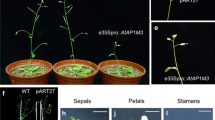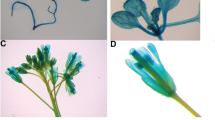Abstract
Main conclusion
We provide evidence that AtDBP1 promotes flowering by regulating the transcript levels of several important integrators and floral meristem identity genes, including FLC, CO, SOC1, LFY, FT and FD.
DNA-binding protein phosphatases (DBP) which exhibit both sequence specific DNA-binding and protein phosphatase 2C activities are important regulators that are involved in both the transcriptional and post-translational regulations. DBP factors are known to mediate susceptibility to potyviruses; however, whether they are involved in other processes is still unclear. In this study, under both long day (LD) and short day conditions, AtDBP1 overexpressing plants displayed early flowering, while the knock out mutants, atdbp1, exhibited a delay in flowering relative to the wild-type plants; both the overexpressing lines and atdbp1 mutants remained photoperiodic sensitive, indicating that AtDBP1 was involved in the autonomous pathway. AtDBP1 does not respond to vernalization at transcript level, and both AtDBP1 overexpressing plants and atdbp1 mutants remain responsive to vernalization, indicating that AtDBP1 may not be directly involved in vernalization. Real-time PCR analysis showed that AtDBP1 can suppress FLOWERING LOCUC C (FLC) expression, a key integrator of the autonomous and vernalization pathways, and enhance the expression levels of CONSTANS and FLOWERING LOCUC T, key regulators of the LD pathway. Furthermore, expression of floral meristem identity genes including SUPPRESSOR OF OVEREXPRESSION OF CO 1, LEAFY and FD was also promoted in AtDBP1overexpressing plants. AtDBP1 transcription can be detected in root, leaf, stem, flower and silique. AtDBP1–GFP and YFP–AtDBP1 fusion protein were localized in the cytosol and nucleus. Our results provide the evidence demonstrating the effective role of AtDBP1 for flowering time regulation and report a novel function of DBP factors in planta besides in plant defense.






Similar content being viewed by others
Abbreviations
- DBP:
-
DNA-binding protein phosphatases
- GA:
-
Gibberellin
- GFP:
-
Green fluorescent protein
- LD:
-
Long day
- PP2C:
-
Protein phosphatase 2C
- SD:
-
Short day
- WT:
-
Wild-type
- YFP:
-
Yellow fluorescent protein
References
Abe M, Kobayashi Y, Yamamoto S, Daimon Y, Yamaguchi A, Ikeda Y, Ichinoki H, Notaguchi M, Goto K, Araki T (2005) FD, a bZIP protein mediating signals from the floral pathway integrator FT at the shoot apex. Science 309:1052–1056
Blázquez MA, Weigel D (2000) Integration of floral inductive signals in Arabidopsis. Nature 404:889–892
Blázquez M, Koornneef M, Putterill J (2001) Flowering on time: genes that regulate the floral transition. EMBO Rep 2:1078–1082
Borner R, Kampmann G, Chandler J, Gleißner R, Wisman E, Apel K, Melzer S (2000) A MADS domain gene involved in the transition to flowering in Arabidopsis. Plant J 24:591–599
Carrasco JL, Ancillo G, Mayda E, Vera P (2003) A novel transcription factor involved in plant defense endowed with protein phosphatase activity. EMBO J 22:3376–3384
Carrasco JL, Ancillo G, Castelló MJ, Vera P (2005) A novel DNA-binding motif, hallmark of a new family of plant transcription factors. Plant Physiol 137:602–606
Carrasco JL, Castelló MJ, Vera P (2006) 14-3-3 mediates transcriptional regulation by modulating nucleocytoplasmic shuttling of tobacco DNA-binding protein phosphatase. J Biol Chem 281:22875–22881
Castello MJ, Carrasco JL, Vera P (2010) DNA-binding protein phosphatase AtDBP1 mediates susceptibility to two potyviruses in Arabidopsis. Plant Physiol 153:1521–1525
Castello MJ, Carrasco JL, Navarrete-Gomez M, Daniel J, Granot D, Vera P (2011) A plant small polypeptide is a novel component of DNA-binding protein phosphatase 1-mediated resistance to plum pox virus in Arabidopsis. Plant Physiol 157:2206–2215
Genoud T, Santa Cruz MT, Kulisic T, Sparla F, Fankhauser C, Métraux J-P (2008) The protein phosphatase 7 regulates phytochrome signaling in Arabidopsis. PLoS One 3:e2699
Gosti F, Beaudoin N, Serizet C, Webb AA, Vartanian N, Giraudat J (1999) ABI1 protein phosphatase 2C is a negative regulator of abscisic acid signaling. Plant Cell 11:1897–1909
Heidari B, Nemie-Feyissa D, Kangasjärvi S, Lillo C (2013) Antagonistic regulation of flowering time through distinct regulatory subunits of protein phosphatase 2A. PLoS One 8:e67987
Hornyik C, Terzi LC, Simpson GG (2010) The spen family protein FPA controls alternative cleavage and polyadenylation of RNA. Dev Cell 18:203–213
Huala E, Sussex IM (1992) LEAFY interacts with floral homeotic genes to regulate Arabidopsis floral development. Plant Cell 4:901–913
Jin JB, Jin YH, Lee J, Miura K, Yoo CY, Kim WY, Van Oosten M, Hyun Y, Somers DE, Lee I (2008) The SUMO E3 ligase, AtSIZ1, regulates flowering by controlling a salicylic acid-mediated floral promotion pathway and through affects on FLC chromatin structure. Plant J 53:530–540
Kardailsky I, Shukla VK, Ahn JH, Dagenais N, Christensen SK, Nguyen JT, Chory J, Harrison MJ, Weigel D (1999) Activation tagging of the floral inducer FT. Science 286:1962–1965
Kim D-H, Kang J-G, Yang S-S, Chung K-S, Song P-S, Park C-M (2002) A phytochrome-associated protein phosphatase 2A modulates light signals in flowering time control in Arabidopsis. Plant Cell 14:3043–3056
Kim J-I, Park J-E, Zarate X, Song P-S (2005) Phytochrome phosphorylation in plant light signaling. Photochem Photobiol Sci 4:681–687
Kobayashi Y, Kaya H, Goto K, Iwabuchi M, Araki T (1999) A pair of related genes with antagonistic roles in mediating flowering signals. Science 286:1960–1962
Koornneef M, Alonso-Blanco C, Peeters AJ, Soppe W (1998) Genetic control of flowering time in Arabidopsis. Annu Rev Plant Biol 49:345–370
Kuhn JM, Boisson-Dernier A, Dizon MB, Maktabi MH, Schroeder JI (2006) The protein phosphatase AtPP2CA negatively regulates abscisic acid signal transduction in Arabidopsis, and effects of abh1 on AtPP2CA mRNA. Plant Physiol 140:127–139
Lee H, Suh S-S, Park E, Cho E, Ahn JH, Kim S-G, Lee JS, Kwon YM, Lee I (2000) The AGAMOUS-LIKE 20 MADS domain protein integrates floral inductive pathways in Arabidopsis. Genes Dev 14:2366–2376
Li W, Ahn I-P, Ning Y, Park C-H, Zeng L, Whitehill JG, Lu H, Zhao Q, Ding B, Xie Q (2012) The U-Box/ARM E3 ligase PUB13 regulates cell death, defense, and flowering time in Arabidopsis. Plant Physiol 159:239–250
Lim M-H, Kim J, Kim Y-S, Chung K-S, Seo Y-H, Lee I, Kim J, Hong CB, Kim H-J, Park C-M (2004) A new Arabidopsis gene, FLK, encodes an RNA binding protein with K homology motifs and regulates flowering time via FLOWERING LOCUS C. Plant Cell 16:731–740
Liu F, Quesada V, Crevillén P, Bäurle I, Swiezewski S, Dean C (2007) The Arabidopsis RNA-binding protein FCA requires a lysine-specific demethylase 1 homolog to downregulate FLC. Mol Cell 28:398–407
Melcher K, Ng LM, Zhou XE, Soon FF, Xu Y, Suino-Powell KM, Park SY, Weiner JJ, Fujii H, Chinnusamy V, Kovach A, Li J, Wang Y, Peterson FC, Jensen DR, Yong EL, Volkman BF, Cutler SR, Zhu JK, Xu HE (2009) A gate–latch–lock mechanism for hormone signalling by abscisic acid receptors. Nature 462:602–608
Merlot S, Gosti F, Guerrier D, Vavasseur A, Giraudat J (2001) The ABI1 and ABI2 protein phosphatases 2C act in a negative feedback regulatory loop of the abscisic acid signalling pathway. Plant J 25:295–303
Meskiene I, Baudouin E, Schweighofer A, Liwosz A, Jonak C, Rodriguez PL, Jelinek H, Hirt H (2003) Stress-induced protein phosphatase 2C is a negative regulator of a mitogen-activated protein kinase. J Biol Chem 278:18945–18952
Michaels SD, Amasino RM (2001) Loss of FLOWERING LOCUS C activity eliminates the late-flowering phenotype of FRIGIDA and autonomous pathway mutations but not responsiveness to vernalization. Plant Cell 13:935–941
Michaels SD, Himelblau E, Kim SY, Schomburg FM, Amasino RM (2005) Integration of flowering signals in winter-annual Arabidopsis. Plant Physiol 137:149–156
Mockler TC, Yu X, Shalitin D, Parikh D, Michael TP, Liou J, Huang J, Smith Z, Alonso JM, Ecker JR (2004) Regulation of flowering time in Arabidopsis by K homology domain proteins. Proc Natl Acad Sci USA 101:12759–12764
Møller SG, Kim Y-S, Kunkel T, Chua N-H (2003) PP7 is a positive regulator of blue light signaling in Arabidopsis. Plant Cell 15:1111–1119
Moon J, Lee H, Kim M, Lee I (2005) Analysis of flowering pathway integrators in Arabidopsis. Plant Cell Physiol 46:292–299
Mouradov A, Cremer F, Coupland G (2002) Control of flowering time interacting pathways as a basis for diversity. Plant Cell 14:S111–S130
Nilsson O, Lee I, Blázquez MA, Weigel D (1998) Flowering-time genes modulate the response to LEAFY activity. Genetics 150:403–410
Nour-Eldin HH, Hansen BG, Norholm MH, Jensen JK, Halkier BA (2006) Advancing uracil-excision based cloning towards an ideal technique for cloning PCR fragments. Nucleic Acids Res 34:e122
Palmer E, Freeman T (2004) Investigation into the use of C- and N-terminal GFP fusion proteins for subcellular localization studies using reverse transfection microarrays. Comp Funct Genomics 5:342–353
Phee B, Kim J, Shin D, Yoo J, Park K, Han Y, Kwon Y, Cho M, Jeon J, Bhoo S (2008) A novel protein phosphatase indirectly regulates phytochrome-interacting factor 3 via phytochrome. Biochem J 415:247–255
Robertson M, Helliwell CA, Dennis ES (2008) Post-translational modifications of the endogenous and transgenic FLC protein in Arabidopsis thaliana. Plant Cell Physiol 49:1859–1866
Samach A, Onouchi H, Gold SE, Ditta GS, Schwarz-Sommer Z, Yanofsky MF, Coupland G (2000) Distinct roles of CONSTANS target genes in reproductive development of Arabidopsis. Science 288:1613–1616
Schomburg FM, Patton DA, Meinke DW, Amasino RM (2001) FPA, a gene involved in floral induction in Arabidopsis, encodes a protein containing RNA-recognition motifs. Plant Cell 13:1427–1436
Searle I, He Y, Turck F, Vincent C, Fornara F, Kröber S, Amasino RA, Coupland G (2006) The transcription factor FLC confers a flowering response to vernalization by repressing meristem competence and systemic signaling in Arabidopsis. Genes Dev 20:898–912
Servet C, Benhamed M, Latrasse D, Kim W, Delarue M, Zhou D-X (2008) Characterization of a phosphatase 2C protein as an interacting partner of the histone acetyltransferase GCN5 in Arabidopsis. Biochim Biophys Acta 1779:376–382
Shalitin D, Yang H, Mockler TC, Maymon M, Guo H, Whitelam GC, Lin C (2002) Regulation of Arabidopsis cryptochrome 2 by blue-light-dependent phosphorylation. Nature 417:763–767
Simpson GG, Dean C (2002) Arabidopsis, the Rosetta stone of flowering time? Science 296:285–289
Song S-K, Lee MM, Clark SE (2006) POL and PLL1 phosphatases are CLAVATA1 signaling intermediates required for Arabidopsis shoot and floral stem cells. Development 133:4691–4698
Song S-K, Hofhuis H, Lee MM, Clark SE (2008) Key divisions in the early Arabidopsis embryo require POL and PLL1 phosphatases to establish the root stem cell organizer and vascular axis. Dev Cell 15:98–109
Srikanth A, Schmid M (2011) Regulation of flowering time: all roads lead to Rome. Cell Mol Life Sci 68:2013–2037
Teper-Bamnolker P, Samach A (2005) The flowering integrator FT regulates SEPALLATA3 and FRUITFULL accumulation in Arabidopsis leaves. Plant Cell 17:2661–2675
Tsuchiya T, Eulgem T (2010) The Arabidopsis defense component EDM2 affects the floral transition in an FLC-dependent manner. Plant J 62:518–528
Wang G-F, Seabolt S, Hamdoun S, Ng G, Park J, Lu H (2011) Multiple roles of WIN3 in regulating disease resistance, cell death, and flowering time in Arabidopsis. Plant Physiol 156:1508–1519
Wigge PA, Kim MC, Jaeger KE, Busch W, Schmid M, Lohmann JU, Weigel D (2005) Integration of spatial and temporal information during floral induction in Arabidopsis. Science 309:1056–1059
Willems E, Leyns L, Vandesompele J (2008) Standardization of real-time PCR gene expression data from independent biological replicates. Anal Biochem 379:127–129
Yoo SK, Chung KS, Kim J, Lee JH, Hong SM, Yoo SJ, Yoo SY, Lee JS, Ahn JH (2005) CONSTANS activates SUPPRESSOR OF OVEREXPRESSION OF CONSTANS 1 through FLOWERING LOCUS T to promote flowering in Arabidopsis. Plant Physiol 139:770–778
Acknowledgments
We thank the NASC for providing mutant seeds used in this study and we would like to thank Ning Jiang from Michigan State University for language editing. This work was supported by National Natural Science Foundation of China [31471518, 31271742 and 31301338]; Chinese Academy of Sciences [Grant KZCX2-EW-303 and Hundred Talents Program, Grant XDA08010105]. Open Fund of Key Laboratory of Mollisols Agroecology, Northeast Institute of Geography and Agroecology, Chinese Academy of Sciences [2011ZKHT-05] and Heilongjiang Postdoctoral Grant [LBH-Z11232].
Author information
Authors and Affiliations
Corresponding author
Additional information
Hong Zhai and Wenfeng Ning have contributed equally to this work.
Rights and permissions
About this article
Cite this article
Zhai, H., Ning, W., Wu, H. et al. DNA-binding protein phosphatase AtDBP1 acts as a promoter of flowering in Arabidopsis . Planta 243, 623–633 (2016). https://doi.org/10.1007/s00425-015-2433-y
Received:
Accepted:
Published:
Issue Date:
DOI: https://doi.org/10.1007/s00425-015-2433-y




